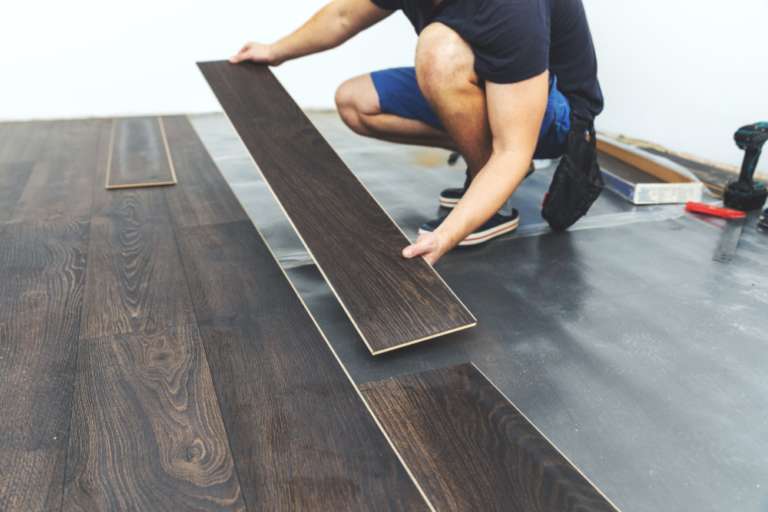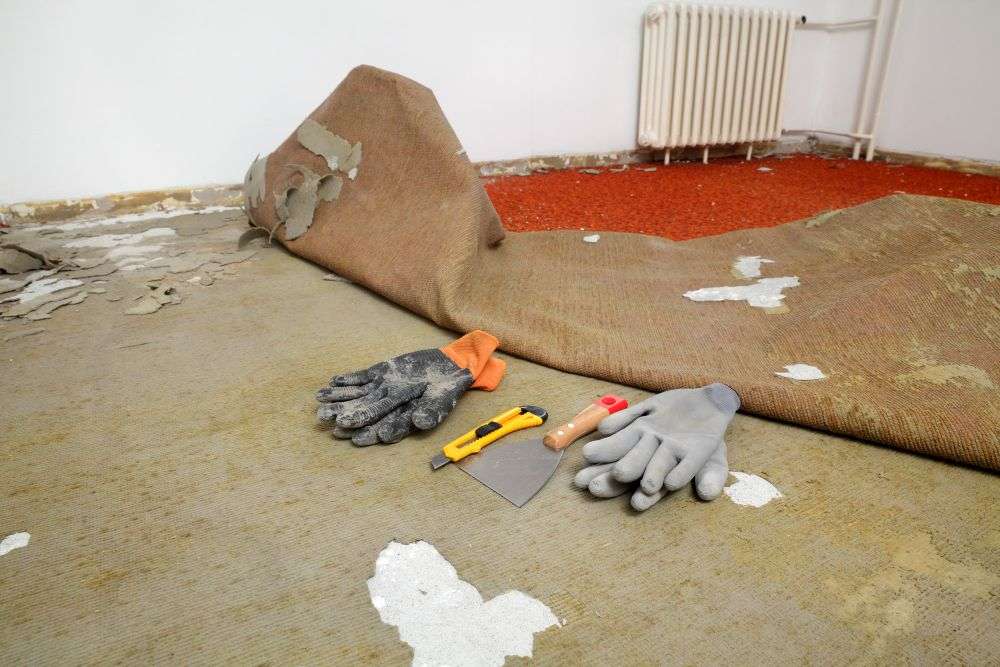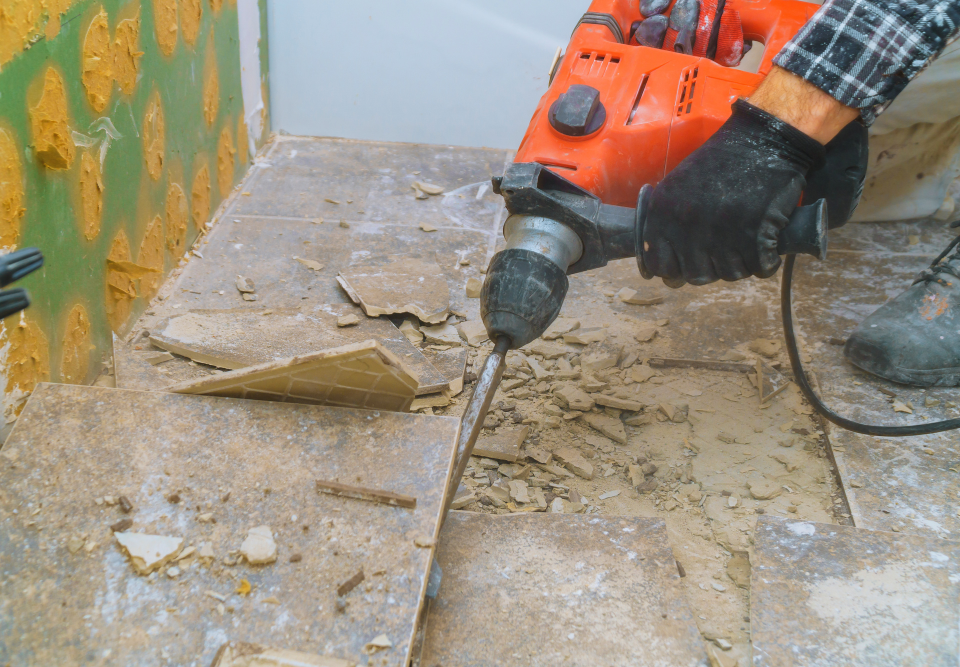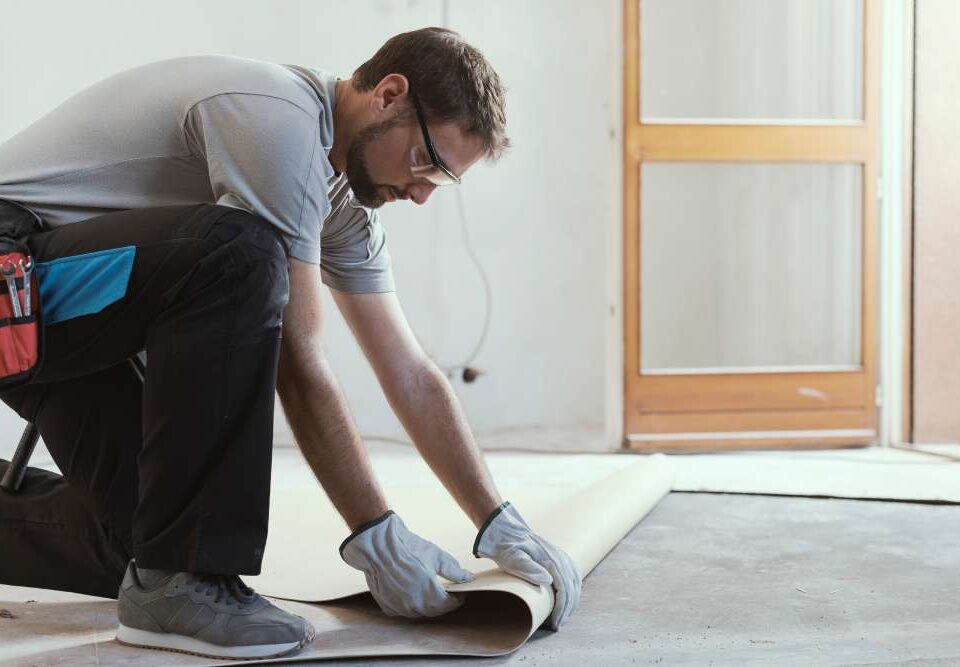
Demolition Cleanup After a Renovation What to Expect
September 7, 2025
How Kitchen Demolition Can Open Up Your Space
September 8, 2025How to Safely Complete Flooring Removal
Removing old flooring is one of those renovation tasks that looks simpler than it is. Beneath the surface, however, it can be a demanding process that requires care, patience, and the right approach. Every type of flooring—from tile and carpet to hardwood—comes with its own challenges, and skipping safety precautions can turn a project into a disaster. By focusing on methodical steps and preparation, homeowners can avoid unnecessary risks while making room for something new. Safe flooring removal is not just about tearing things up—it’s about protecting yourself, your home, and ensuring the ground is ready for its next transformation.
Understanding the importance of preparation
The success of flooring removal begins before any tool touches the surface. Proper preparation means clearing the space completely, removing furniture, and protecting walls and fixtures from dust or damage. It’s easy to underestimate this step, but starting in a clutter-free environment keeps you from tripping over obstacles or accidentally damaging belongings. Preparation also sets the tone for efficiency, allowing the removal process to flow without constant interruptions.
Equally important is planning how the debris will be handled once the flooring comes up. Flooring materials are heavy, awkward, and can generate a surprising amount of waste. Without a disposal strategy, you may find yourself buried in piles of broken tile, splintered wood, or carpet scraps. Thinking ahead about removal methods—whether hauling it yourself or arranging professional junk removal—saves time and reduces stress. Preparation ensures the project feels manageable from start to finish.
Choosing the right tools for the job
Not all flooring requires the same tools for removal. For carpet, utility knives, pliers, and staple pullers are essential. For tile, you may need chisels, pry bars, and sometimes even a hammer drill for stubborn sections. Hardwood removal often requires crowbars, mallets, and heavy-duty gloves to deal with nails and splinters. The wrong tool slows progress and can even make the job dangerous. Selecting the proper gear is as important as knowing how to use it safely.
Investing in quality tools also pays off in reduced effort. Dull blades or cheap chisels can cause slips, leading to cuts or strained muscles. Specialized tools, while they may feel unnecessary at first, often save hours of hard labor and frustration. Before beginning, gather everything in one place and double-check that tools are in good working order. Being prepared with the right equipment ensures smoother, safer flooring removal every time.

Protecting yourself with proper safety gear
Flooring removal produces dust, splinters, and sharp debris that can pose serious hazards. Protective gear should never be optional. Safety glasses shield your eyes from flying particles, while gloves protect against cuts from nails, edges, and splintered materials. A sturdy dust mask or respirator is also vital, especially when dealing with older flooring that may contain harmful adhesives or chemicals. Protection is about prevention, and it starts before the first strike of a hammer.
Footwear is another key component that is sometimes overlooked. Heavy, closed-toe shoes or boots guard against punctures from nails and dropped tools. Knee pads can also make long sessions on the floor less punishing and reduce strain. By dressing for safety, you minimize the risks of accidents and create peace of mind during the process. Flooring removal is challenging enough—there’s no reason to add injuries into the mix.
Handling different types of flooring safely
Every flooring type comes with unique challenges, and knowing how to handle each makes removal safer. Carpet often hides layers of staples and tack strips that can tear skin or cause puncture wounds if not handled carefully. Tile removal is notorious for flying shards, so taking time to work in small sections helps control debris. Hardwood can be stubborn, especially if glued or nailed down, and prying boards up without proper leverage can strain your back.
Laminate or vinyl floors can peel up more easily but may reveal old adhesive underneath that requires careful scraping. Each surface demands patience, and rushing the process often leads to mistakes. Working methodically not only prevents injury but also reduces the chance of damaging the subfloor. Recognizing the differences in flooring materials prepares you to adapt your approach and complete the job without unnecessary complications.
Managing dust and debris effectively
Flooring removal creates an incredible amount of mess, and dust control is one of the biggest challenges. Fine particles from concrete backer board, adhesives, or even grout can travel throughout the house if not contained. Sealing off doorways with plastic sheeting and using fans or vacuums to control air movement helps minimize the spread. This not only protects your home but also reduces potential respiratory issues.
Debris management is equally important. Broken tiles, splintered boards, or rolled-up carpet can quickly take over the space if not moved out regularly. Keeping a system in place—whether that’s hauling debris as you go or stacking it neatly until pickup—makes the process more organized. A clean workspace improves efficiency and makes it easier to stay safe. By addressing dust and debris from the beginning, flooring removal becomes far less overwhelming.
Preventing damage to the subfloor
The subfloor is the hidden structure that supports everything above, and protecting it during removal is essential. Heavy-handed prying or overzealous hammering can cause cracks, holes, or uneven surfaces that require costly repairs before new flooring can be installed. Working carefully, section by section, reduces the risk of long-term damage. Tools should be angled precisely to lift material without gouging into the wood or concrete beneath.
After the flooring is gone, it’s also important to inspect the subfloor for any hidden issues. Moisture damage, mold, or warping may be revealed once the surface is cleared. Addressing these problems immediately ensures that the new flooring rests on a solid foundation. Preserving the integrity of the subfloor is one of the most critical steps in safe flooring removal, as it saves time, money, and frustration later.
Understanding when professional help is needed
While many homeowners take on flooring removal themselves, some projects require professional intervention. Flooring that has been glued with industrial adhesives, or tile that was set with thick mortar, may resist basic tools. In some cases, specialized equipment like power scrapers or jackhammers is necessary, and without training, these tools can be hazardous. Recognizing when the job has exceeded your capabilities is a form of safety in itself.
There are also health concerns that call for expert assistance. Older flooring materials may contain asbestos or lead-based adhesives, both of which pose significant risks if disturbed. Professionals are trained to handle these situations safely and ensure proper disposal. Knowing your limits and when to call in help keeps the project efficient and minimizes unnecessary dangers. Sometimes, letting an expert handle the toughest parts is the safest decision you can make.
Disposing of flooring materials responsibly
After removal, disposal becomes the next challenge. Old flooring is bulky, heavy, and often not suitable for curbside pickup. Carpet, padding, tiles, and wood all need proper handling to prevent environmental harm. Simply dumping them in a landfill is not always the most responsible choice, especially when recycling options are available. Some materials can be repurposed, reducing waste and supporting sustainability.
Arranging professional junk removal ensures that debris is managed correctly. Experts know how to separate recyclable materials and dispose of hazardous substances safely. They also spare homeowners the effort of lifting and transporting heavy loads, which can cause injuries. Responsible disposal is not just about clearing space—it’s about doing so in a way that benefits both the homeowner and the environment. Taking this step seriously closes the flooring removal process with responsibility and care.
Creating a safe and efficient workflow
A safe flooring removal process is also an organized one. Tackling the project in sections prevents fatigue and keeps the space manageable. Starting from one corner and moving systematically reduces confusion and prevents overlooked spots. Pausing regularly to clear debris and reassess progress maintains focus and keeps the worksite safe. Efficiency comes from structure, not speed.
Establishing a clear workflow also makes it easier to adapt when challenges arise. Whether it’s a stubborn section of tile or hidden nails under carpet, having a plan keeps frustration in check. Working steadily instead of rushing minimizes mistakes that could lead to injury or damage. With a thoughtful workflow, flooring removal becomes less chaotic and more controlled, paving the way for a smoother renovation.
Preparing the space for new flooring
The final stage of flooring removal is preparing for what comes next. Once the old material is gone, it’s essential to clean thoroughly, removing dust, nails, and adhesive residue. This creates a smooth surface for the installation of new flooring, ensuring it bonds properly and lasts longer. Skipping this step can lead to premature wear, uneven surfaces, or costly repairs down the road.
Beyond cleaning, homeowners should also check for moisture, level the subfloor, and make any necessary adjustments. These finishing touches guarantee that the upcoming installation has the best possible foundation. Preparing the space properly ensures that all the effort spent on safe removal pays off in the final result. It’s the bridge between demolition and renewal, setting the stage for a fresh start.
Conclusion
Flooring removal may seem straightforward, but the process requires patience, planning, and attention to safety. From protecting yourself with proper gear to preserving the integrity of the subfloor, each step plays a vital role in ensuring success. Handling different flooring types with care, managing dust and debris, and knowing when to call in professionals keeps the project both safe and efficient. Preparing the space thoroughly allows new flooring to be installed on a clean, stable foundation that will last for years.
For those who want expert assistance with debris disposal, North Bay Junk Removal is a trusted partner. Located in Santa Rosa, CA, they specialize in junk removal services that make flooring projects easier and safer for homeowners. With reliable service and professional care, they handle the toughest cleanup jobs efficiently, so you can focus on the transformation ahead. To schedule support for your project, call North Bay Junk Removal today at 707-478-6817.



